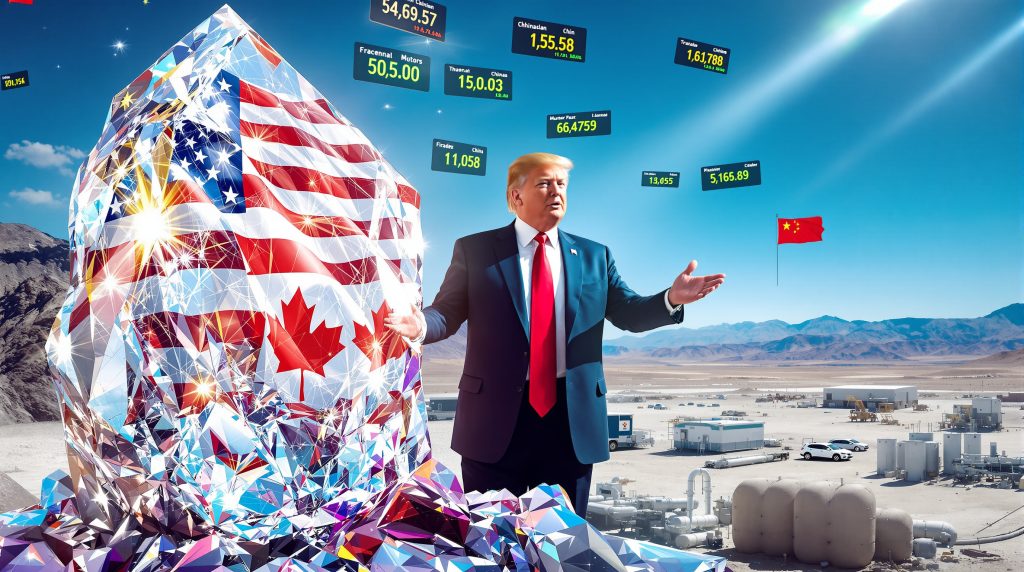What Is Driving the Trump Administration's Interest in Lithium Americas?
The Trump administration's pursuit of an equity stake in Lithium Americas represents a significant shift in U.S. resource security strategy. This move comes amid growing concerns about China's dominance in critical minerals, with the U.S. importing over 95% of its lithium needs while China controls approximately 60% of global lithium processing capacity. The administration's strategic pivot toward direct investment in mineral resources reflects a broader policy approach focused on securing domestic supply chains for strategic resources critical to both economic and national security interests.
The Strategic Value of Thacker Pass
Located in northern Nevada, Thacker Pass is positioned to become one of North America's largest lithium sources. With a projected annual production capacity of 40,000 metric tons of lithium carbonate, this mine represents a cornerstone of domestic lithium supply development in the United States.
General Motors has already recognized the strategic importance of this resource, securing offtake agreements for future production to support its ambitious electric vehicle manufacturing goals. This private-sector interest underscores the commercial viability of the project beyond its national security implications.
The mine's development timeline has gained significant attention as domestic lithium production becomes increasingly vital to U.S. industrial policy. Industry analysts project that North American mining trends could increase tenfold by 2030, driven primarily by electric vehicle battery manufacturing requirements.
Financial Structure of the Proposed Deal
At the center of this strategic investment is the renegotiation of an existing $2.2 billion Department of Energy loan. According to a Trump administration official, the equity stake is being proposed in exchange for modified loan repayment terms after Lithium Americas missed conditions necessary for the first disbursement.
The administration is seeking what has been described as a "very small stake" to create a financial buffer for taxpayers. As one administration official explained, "If we're going to push out part of the repayment into later years, then the administration would like a very small stake of equity to create essentially a cash buffer and eliminate some risk on behalf of taxpayers."
This approach represents an innovative financial structure that balances commercial development needs with taxpayer protection. By extending the loan repayment schedule into later years while taking an equity position, the government gains potential upside exposure to offset the increased repayment risk.
Industry financial analysts note that this structure could become a model for future critical minerals energy transition investments, providing government support while maintaining appropriate risk management measures.
How Does This Move Fit Into Broader U.S. Resource Strategy?
The Lithium Americas equity stake proposal represents the latest development in an evolving national resource security framework. This approach marks a significant departure from traditional U.S. industrial policy, which has historically relied on private sector development with limited government intervention.
Pattern of Strategic Mineral Investments
The proposed equity stake in Lithium Americas follows a July 2025 Department of Defense acquisition of a 15% stake in MP Materials, a rare earth mining company based in Las Vegas. That investment proved commercially successful, with MP Materials shares doubling in value following the government's involvement.
This strategic pattern represents an expansion of U.S. resource security strategy to include North American allies. The Lithium Americas deal would mark the first proposed equity stake in a Canadian-incorporated mining company, signaling a continental approach to resource security.
The cross-border nature of this investment reflects a whole-of-government approach to critical mineral security, spanning the Departments of Defense, Energy, and Interior in a coordinated strategy to secure vital resources.
Industry observers note that this approach bears similarities to models employed by other major economies, particularly in East Asia and Europe, where government investment in strategic industries has long been standard practice.
Market Response to the Announcement
Financial markets have responded enthusiastically to the announcement, with Lithium Americas stock surging approximately 70% in premarket trading. This dramatic price movement demonstrates strong market validation of government involvement in critical resource development.
Trading activity increased significantly on both the NYSE and Toronto Stock Exchange following the news, reflecting heightened investor confidence boosted by implied government backing. This parallels the market response to previous strategic mineral investments, particularly the MP Materials deal.
Market analysts suggest this price action demonstrates that government involvement adds substantial perceived value beyond traditional project economics. This premium reflects both reduced execution risk and strategic positioning in an increasingly competitive global minerals landscape.
What Challenges Does the Equity Stake Proposal Face?
Despite its strategic rationale, the proposed equity stake faces several significant hurdles that could complicate or potentially derail the arrangement.
Regulatory and Jurisdictional Complexities
Lithium Americas' incorporation and domiciliation in Canada creates unique jurisdictional challenges for a U.S. government investment. This cross-border dimension potentially requires Canadian regulatory approval under that country's foreign investment review framework.
The company's dual-listed status on the Toronto Stock Exchange and NYSE creates multi-jurisdictional considerations that add layers of complexity beyond a purely domestic investment. This precedent-setting nature of cross-border strategic investment in a Canadian mining company will require navigation of both U.S. and Canadian regulatory frameworks.
Canadian investment laws typically scrutinize foreign government investments more closely than private transactions, with national security considerations playing a significant role. The Investment Canada Act establishes specific thresholds and review procedures for foreign government investments in Canadian companies, particularly those involved in natural resource development.
Financial and Operational Considerations
The equity stake proposal emerged after Lithium Americas failed to meet the original loan conditions required for the first disbursement. The company subsequently requested an extended repayment timeline, prompting the government to seek equity as a risk mitigation measure.
This restructuring requires balancing taxpayer protection with project advancement goals. Both parties must ensure the operational timeline remains on track despite the financial restructuring to meet broader strategic mineral security objectives.
Financial analysts note that government equity positions can sometimes create governance complexities, with potentially competing priorities between commercial optimization and policy objectives. Establishing clear governance frameworks will be essential to maintain operational effectiveness.
How Does This Strategy Counter Chinese Dominance in Critical Minerals?
The Trump administration's pursuit of equity stakes in strategic mineral companies represents a direct response to China's dominant position in global critical mineral supply chains.
U.S. Strategic Positioning
Direct government ownership in the critical mineral supply chain represents a fundamental shift in U.S. industrial policy. This approach aims to reduce dependence on Chinese-controlled resources by creating domestic alternatives for battery material supply.
By supporting North American industrial capacity development, the strategy implements policy statements from Interior Secretary Doug Burgum's April 2025 announcements regarding critical mineral security. Burgum revealed that the Trump administration was considering taking equity stakes in miners specifically to counter state-sponsored competition from China.
The strategic mineral portfolio being assembled across multiple investments creates a more resilient resource base for advanced technology manufacturing. By securing upstream resource positions, the U.S. aims to prevent supply chain vulnerabilities that could threaten manufacturing independence.
Competitive Response to State-Backed Enterprises
China's critical minerals strategy has long leveraged state-sponsored mineral development through direct ownership, subsidized financing, and regulatory advantages. The U.S. equity stake approach directly counters this model by providing comparable financial backing to domestic producers.
These public-private partnerships in strategic sectors leverage government resources to accelerate development timelines that would be difficult to match with purely private capital. The approach ensures competitive positioning against state-backed competitors operating with non-market advantages.
Industry experts note that China controls approximately 75% of battery cell manufacturing capacity globally, with similar dominance across multiple critical mineral processing segments. Even lithium mined in other countries is frequently sent to China for processing, creating supply chain vulnerabilities that the Trump critical minerals order aims to address.
What Are the Implications for North American Resource Development?
The proposed equity stake in a Canadian-incorporated mining company signals a more integrated approach to continental resource security.
Continental Resource Security Framework
The investment strengthens U.S.-Canada resource cooperation, creating integrated North American supply chains that reduce collective dependence on overseas suppliers. This establishes a precedent for cross-border strategic investments that could expand to include other critical mineral projects.
The approach develops a regional resource security architecture that leverages the complementary strengths of both countries. Canada's substantial mineral resources combined with U.S. financial capacity and manufacturing base creates a more resilient continental system.
Trade experts note that qualifying North American lithium production could benefit from USMCA provisions, potentially creating additional competitive advantages for regionally produced materials compared to imports from outside North America.
Electric Vehicle Supply Chain Development
The investment directly supports domestic battery material production essential to North American vehicle electrification plans. General Motors and other automakers benefit from reduced transportation and logistics costs through proximity to lithium production.
This approach creates resilient supply chains resistant to international disruption while accelerating North American EV manufacturing capacity development. Industry analysts project that North American lithium processing capacity currently falls significantly below projected demand, creating a strategic opportunity for expanded regional processing infrastructure.
The reduced geopolitical risk associated with continental supply chains could potentially translate to more stable pricing and supply security for downstream manufacturers, creating competitive advantages for North American production.
How Will This Investment Impact Domestic Mining Development?
Government involvement in strategic mining projects could fundamentally alter the development landscape for critical mineral projects throughout North America.
Project Acceleration Effects
Government backing potentially streamlines permitting processes that have historically created significant delays for U.S. mining projects. According to industry data, major mine permitting in the U.S. typically takes 7-10 years compared to 2-3 years in other mining jurisdictions.
The equity stake should increase investor confidence in domestic mining projects more broadly, with potential for expedited development timelines across the sector. The additional financial flexibility through modified loan terms reduces project execution risk through government partnership.
Mineral development specialists note that government participation can help navigate complex regulatory frameworks, potentially reducing the administrative burden that has historically challenged U.S. mining development. This could create a more favorable environment for additional critical mineral projects beyond Thacker Pass.
Environmental and Social Governance Considerations
Despite acceleration potential, the project must maintain high environmental standards throughout the development process. The government equity stake creates an opportunity for balancing resource security with environmental protection by establishing best practices that could influence the broader industry.
The Thacker Pass development could set standards for responsible domestic resource development, creating a model for sustainable critical mineral production. This approach demonstrates the potential compatibility of mining with environmental stewardship when proper safeguards are maintained.
Environmental experts emphasize that domestic production under US mineral production order typically results in lower lifecycle emissions compared to minerals produced in jurisdictions with less stringent environmental controls. This creates potential for "greener" battery materials when full supply chain impacts are considered.
What Does This Mean for Investors in the Critical Minerals Sector?
The government's strategic investment approach creates significant implications for investors across the critical minerals landscape.
Investment Implications
The dramatic market response to the Lithium Americas announcement suggests potential for similar government investments in other strategic mineral companies. This prospect has increased market interest in domestic mining operations across multiple critical mineral categories.
The government involvement provides validation of the critical mineral investment thesis that has attracted growing attention from institutional investors. Companies with assets positioned as strategically important to U.S. interests may see reduced perceived risk and improved financing terms.
Financial analysts note that projects with national security implications may command premium valuations compared to otherwise similar mining assets without strategic designation. This creates potential investment opportunities in companies with critical mineral assets not yet recognized for their strategic value.
Market Sector Transformation
The strategic investment approach is driving revaluation of North American mineral assets based on their strategic positioning rather than purely commercial metrics. This shift increases capital availability for strategic projects that might otherwise struggle to secure financing based solely on traditional mining economics.
The growing investor focus on domestic supply chain development reflects recognition that government policy is becoming a significant value driver in the sector. This represents a fundamental shift from purely commercial to strategic-commercial valuation models.
Investment strategists suggest that critical mineral companies may increasingly emphasize their strategic relevance in investor communications, highlighting national security applications alongside commercial potential. This reflects the emerging reality that government priorities will continue shaping investment flows in the sector despite ongoing lithium market challenges.
FAQ: Trump Administration's Lithium Americas Investment
What is the current status of the equity stake negotiation?
Negotiations are ongoing with no finalized agreement yet. The Trump administration has expressed support for the project, and discussions are described as positive by administration officials. Both sides appear motivated to reach an arrangement that satisfies both commercial and strategic objectives.
How much of Lithium Americas would the government own?
While exact percentages haven't been disclosed, officials have indicated it would be a "very small stake" designed primarily to create a cash buffer and reduce taxpayer risk. Based on similar precedents like the MP Materials investment, analysts speculate the stake could range from 5-15% of the company.
Why is the government pursuing equity rather than just loan guarantees?
The equity component was proposed in response to Lithium Americas' request to extend loan repayment terms. The administration views equity as a risk mitigation measure that provides taxpayers with potential upside while accommodating the company's financial needs. This structure creates better alignment between government support and project success.
Would this deal require Canadian government approval?
Yes, since Lithium Americas is incorporated in Canada, the investment may require Canadian regulatory approval, adding a layer of complexity to the negotiations. The Investment Canada Act establishes specific review procedures for foreign government investments in Canadian companies, particularly those in natural resource sectors.
How does this compare to other government investments in critical minerals?
This follows the pattern established with MP Materials, where the Department of Defense took a 15% stake in July 2025. The key difference is that Lithium Americas would represent the first such investment in a Canadian-incorporated company, expanding the strategy to include North American allies in the critical minerals security framework.
Conclusion: Strategic Significance of Government Mineral Investments
The Trump administration's pursuit of an equity stake in Lithium Americas marks a significant evolution in U.S. resource security policy. By taking direct ownership positions in critical mineral producers, the government is creating a new model for public-private partnership in strategic sectors. This approach combines financial support with structural alignment between national security interests and commercial development.
The market response—with Lithium Americas shares surging 70% on the news—validates the commercial significance of government backing. For investors, mining companies, and downstream manufacturers, this signals a fundamental shift in how critical mineral assets are valued and developed in North America.
As the U.S. continues to build domestic alternatives to Chinese-dominated supply chains, strategic equity investments may become a standard tool in the government's resource security toolkit. The Lithium Americas case demonstrates how financial restructuring, government participation, and national security priorities can converge to accelerate critical resource development while protecting taxpayer interests.
Looking to Capitalise on the Next Major ASX Mineral Discovery?
Don't miss out on tomorrow's market-moving mineral announcement – Discovery Alert's proprietary Discovery IQ model delivers instant notifications of significant ASX discoveries, transforming complex mineral data into actionable investment opportunities. Visit Discovery Alert's discoveries page to explore why historic discoveries generate substantial returns and begin your 30-day free trial today.




